Histone H3 (tri methyl K9) Mouse Monoclonal Antibody [1-6]

cat.: M1112-3
| Product Type: | Mouse monoclonal IgG1, primary antibodies |
|---|---|
| Species reactivity: | Human, Mouse, Rat |
| Applications: | WB, IF-Cell, IHC-P, IF-Tissue |
| Clonality: | Monoclonal |
| Clone number: | 1-6 |
| Form: | Liquid |
| Storage condition: | Shipped at 4℃. Store at +4℃ short term (1-2 weeks). It is recommended to aliquot into single-use upon delivery. Store at -20℃ long term. |
| Storage buffer: | 1*PBS (pH7.4), 0.2% BSA, 50% Glycerol. Preservative: 0.05% Sodium Azide. |
| Concentration: | 2ug/ul |
| Purification: | Protein G affinity purified. |
| Molecular weight: | Predicted band size: 15 kDa |
| Isotype: | IgG1 |
| Immunogen: | Synthetic peptide within N terminal human Histone H3 including tri methyl K9 conjugated to keyhole limpet haemocyanin. |
| Positive control: | F9 cell lysate, PC-12 cell lysate, NCCIT cell lysate, HeLa, NIH/3T3, human testis tissue, mouse testis tissue, mouse epididymis tissue, rat testis tissue. |
| Subcellular location: | Nucleus. |
| Recommended Dilutions:
WB IF-Cell IHC-P IF-Tissue |
1:5,000-1:10,000 1:250 1:1,000 1:200 |
| Uniprot #: | SwissProt: P68431 Human | P68433 Mouse | Q6LED0 Rat |
| Alternative names: | H3K9me3 H3 histone family member E pseudogene H3 histone family, member A H3/A H31_HUMAN H3F3 H3FA Hist1h3a HIST1H3B HIST1H3C HIST1H3D HIST1H3E HIST1H3F HIST1H3G HIST1H3H HIST1H3I HIST1H3J HIST3H3 histone 1, H3a Histone cluster 1, H3a Histone H3 3 pseudogene Histone H3.1 Histone H3/a Histone H3/b Histone H3/c Histone H3/d Histone H3/f Histone H3/h Histone H3/i Histone H3/j Histone H3/k Histone H3/l H3K9me3 |
Images
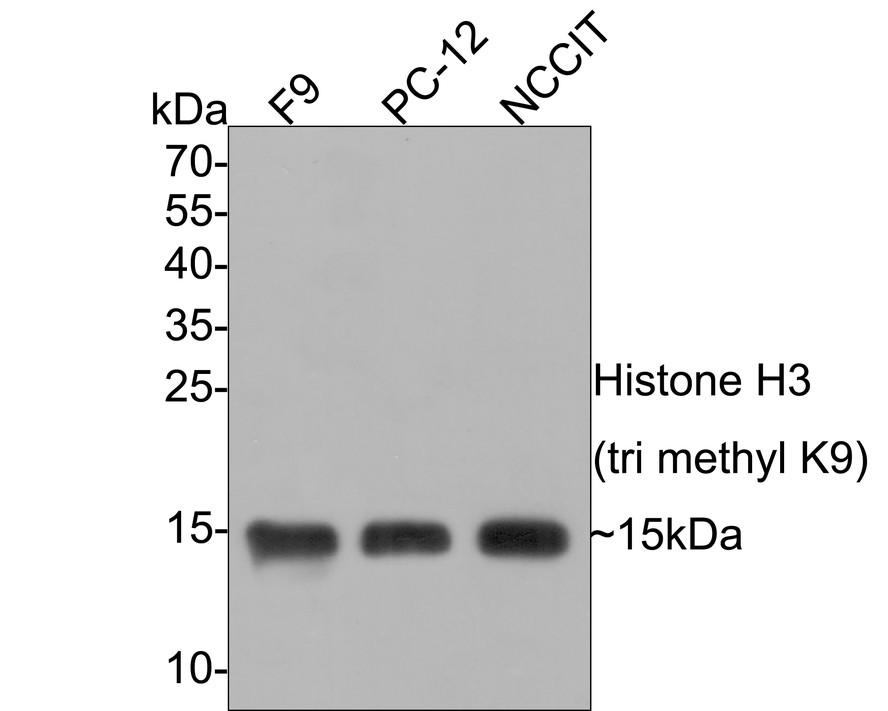
|
Fig1:
Western blot analysis of Histone H3 (tri methyl K9) on different lysates with Mouse anti-Histone H3 (tri methyl K9) antibody (M1112-3) at 1/1,000 dilution. Lane 1: F9 cell lysate Lane 2: PC-12 cell lysate Lane 3: NCCIT cell lysate Lysates/proteins at 10 µg/Lane. Predicted band size: 15 kDa Observed band size: 15 kDa Exposure time: minute; 15% SDS-PAGE gel. Proteins were transferred to a PVDF membrane and blocked with 5% NFDM/TBST for 1 hour at room temperature. The primary antibody (M1112-3) at 1/1,000 dilution was used in 5% NFDM/TBST at room temperature for 2 hours. Goat Anti-Mouse IgG - HRP Secondary Antibody (HA1006) at 1:100,000 dilution was used for 1 hour at room temperature. |

|
Fig2:
Western blot analysis of Tri-Methyl-Histone H3 (Lys9) on different lysates. Proteins were transferred to a PVDF membrane and blocked with 5% BSA in PBS for 1 hour at room temperature. The primary antibody (M1112-3, 1/2,000) was used in 5% BSA at room temperature for 2 hours. Goat Anti-Mouse IgG - HRP Secondary Antibody (HA1006) at 1:5,000 dilution was used for 1 hour at room temperature. Positive control: Lane A: F9 cell lysate Lane B: F9+non-methyl peptide Lane C: F9+Tri-methl (lys9) peptide Lane D: PC12 cell lysate Lane E: NCCIT cell lysate |
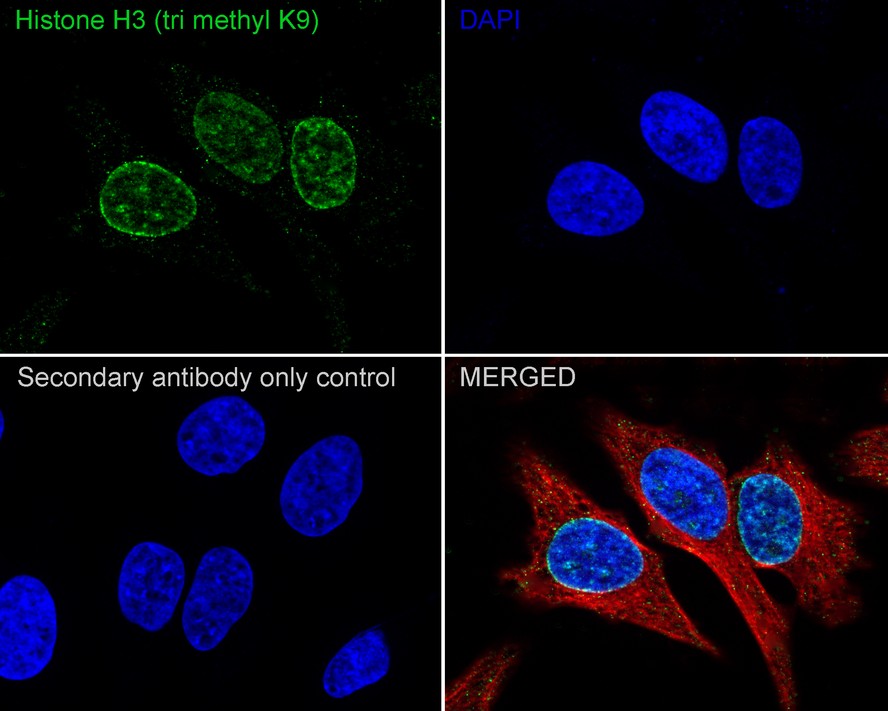
|
Fig3:
Immunocytochemistry analysis of HeLa cells labeling Histone H3 (tri methyl K9) with Mouse anti-Histone H3 (tri methyl K9) antibody (M1112-3) at 1/250 dilution. Cells were fixed in 4% paraformaldehyde for 20 minutes at room temperature, permeabilized with 0.1% Triton X-100 in PBS for 5 minutes at room temperature, then blocked with 1% BSA in 10% negative goat serum for 1 hour at room temperature. Cells were then incubated with Mouse anti-Histone H3 (tri methyl K9) antibody (M1112-3) at 1/250 dilution in 1% BSA in PBST overnight at 4 ℃. Goat Anti-Mouse IgG H&L (iFluor™ 488, HA1125) was used as the secondary antibody at 1/1,000 dilution. PBS instead of the primary antibody was used as the secondary antibody only control. Nuclear DNA was labelled in blue with DAPI. beta Tubulin (ET1602-4, red) was stained at 1/100 dilution overnight at +4℃. Goat Anti-Rabbit IgG H&L (iFluor™ 594, HA1122) were used as the secondary antibody at 1/1,000 dilution. |
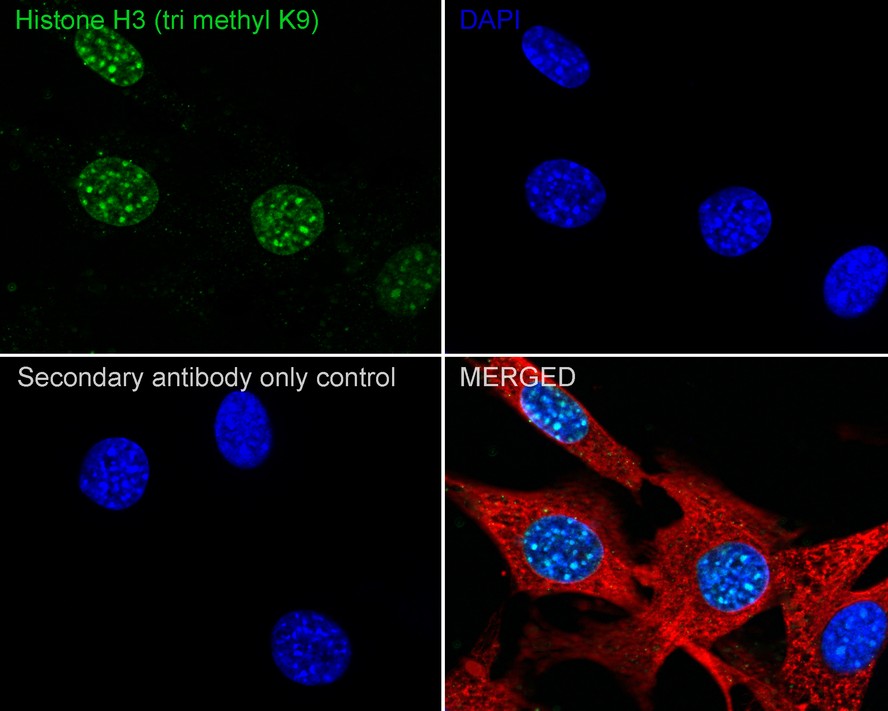
|
Fig4:
Immunocytochemistry analysis of NIH/3T3 cells labeling Histone H3 (tri methyl K9) with Mouse anti-Histone H3 (tri methyl K9) antibody (M1112-3) at 1/250 dilution. Cells were fixed in 4% paraformaldehyde for 20 minutes at room temperature, permeabilized with 0.1% Triton X-100 in PBS for 5 minutes at room temperature, then blocked with 1% BSA in 10% negative goat serum for 1 hour at room temperature. Cells were then incubated with Mouse anti-Histone H3 (tri methyl K9) antibody (M1112-3) at 1/250 dilution in 1% BSA in PBST overnight at 4 ℃. Goat Anti-Mouse IgG H&L (iFluor™ 488, HA1125) was used as the secondary antibody at 1/1,000 dilution. PBS instead of the primary antibody was used as the secondary antibody only control. Nuclear DNA was labelled in blue with DAPI. beta Tubulin (ET1602-4, red) was stained at 1/100 dilution overnight at +4℃. Goat Anti-Rabbit IgG H&L (iFluor™ 594, HA1122) were used as the secondary antibody at 1/1,000 dilution. |
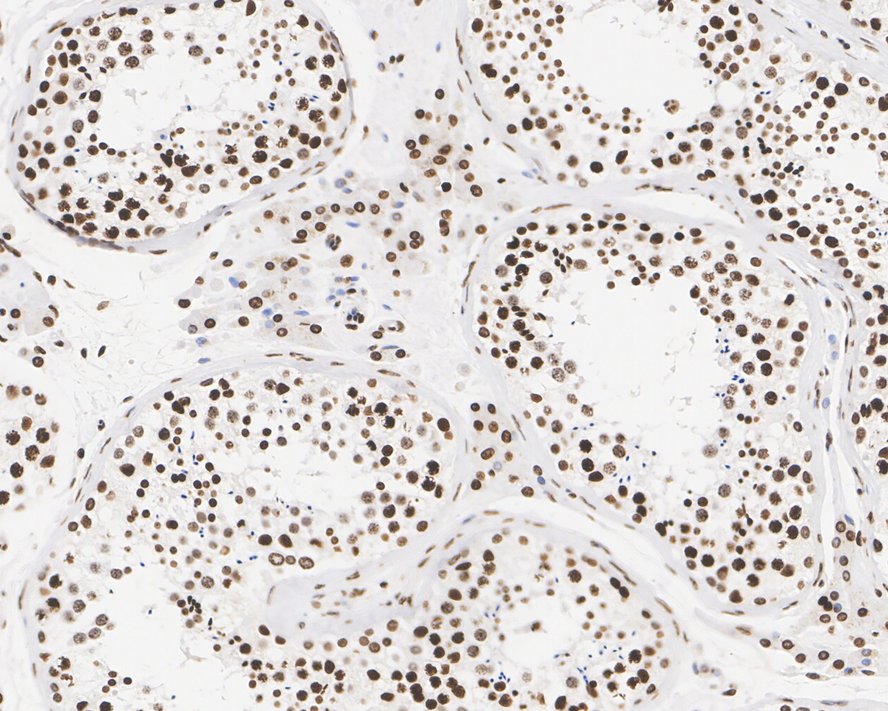
|
Fig5:
Immunohistochemical analysis of paraffin-embedded human testis tissue with Mouse anti-Histone H3 (tri methyl K9) antibody (M1112-3) at 1/1,000 dilution. The section was pre-treated using heat mediated antigen retrieval with sodium citrate buffer (pH 6.0) for 2 minutes. The tissues were blocked in 1% BSA for 20 minutes at room temperature, washed with ddH2O and PBS, and then probed with the primary antibody (M1112-3) at 1/1,000 dilution for 1 hour at room temperature. The detection was performed using an HRP conjugated compact polymer system. DAB was used as the chromogen. Tissues were counterstained with hematoxylin and mounted with DPX. |

|
Fig6:
Immunohistochemical analysis of paraffin-embedded mouse testis tissue with Mouse anti-Histone H3 (tri methyl K9) antibody (M1112-3) at 1/1,000 dilution. The section was pre-treated using heat mediated antigen retrieval with sodium citrate buffer (pH 6.0) for 2 minutes. The tissues were blocked in 1% BSA for 20 minutes at room temperature, washed with ddH2O and PBS, and then probed with the primary antibody (M1112-3) at 1/1,000 dilution for 1 hour at room temperature. The detection was performed using an HRP conjugated compact polymer system. DAB was used as the chromogen. Tissues were counterstained with hematoxylin and mounted with DPX. |
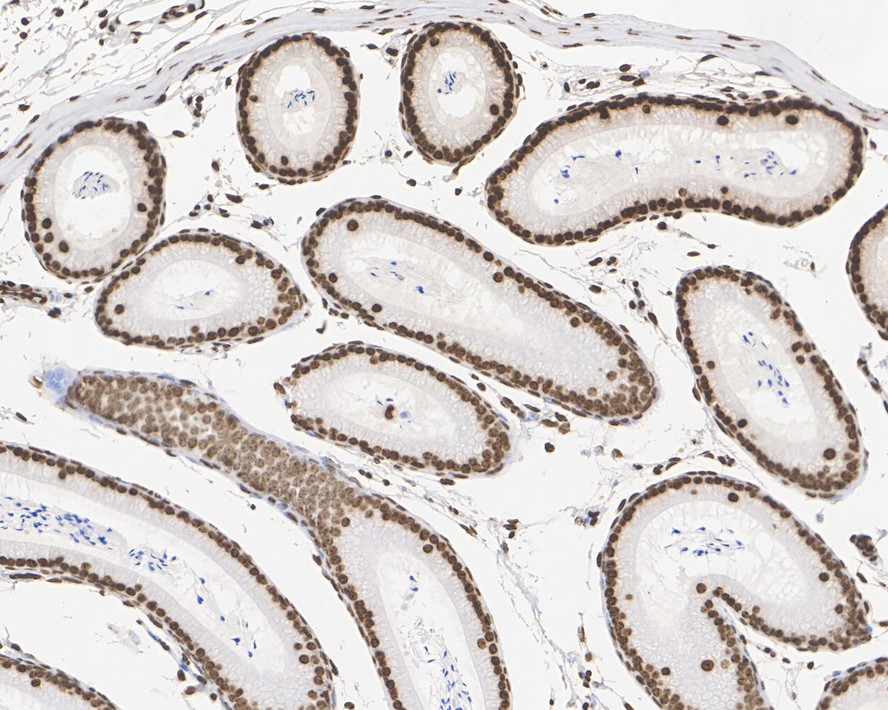
|
Fig7:
Immunohistochemical analysis of paraffin-embedded mouse epididymis tissue with Mouse anti-Histone H3 (tri methyl K9) antibody (M1112-3) at 1/1,000 dilution. The section was pre-treated using heat mediated antigen retrieval with sodium citrate buffer (pH 6.0) for 2 minutes. The tissues were blocked in 1% BSA for 20 minutes at room temperature, washed with ddH2O and PBS, and then probed with the primary antibody (M1112-3) at 1/1,000 dilution for 1 hour at room temperature. The detection was performed using an HRP conjugated compact polymer system. DAB was used as the chromogen. Tissues were counterstained with hematoxylin and mounted with DPX. |
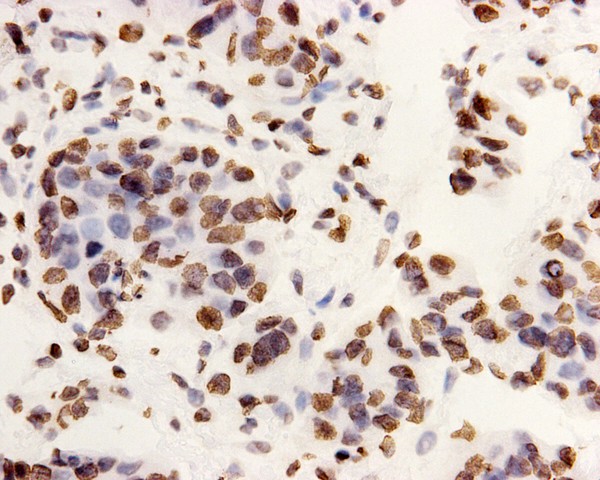
|
Fig8: Immunohistochemical analysis of paraffin-embedded rat testis tissue using anti-Tri-Methyl-Histone H3 (Lys9) antibody. The section was pre-treated using heat mediated antigen retrieval with Tris-EDTA buffer (pH 8.0-8.4) for 20 minutes.The tissues were blocked in 5% BSA for 30 minutes at room temperature, washed with ddH2O and PBS, and then probed with the primary antibody (M1112-3, 1/100) for 30 minutes at room temperature. The detection was performed using an HRP conjugated compact polymer system. DAB was used as the chromogen. Tissues were counterstained with hematoxylin and mounted with DPX. |
Note: All products are “FOR RESEARCH USE ONLY AND ARE NOT INTENDED FOR DIAGNOSTIC OR THERAPEUTIC USE”.